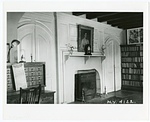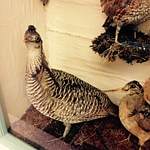Bell's Birds
When Maria Gagliardi became the director of the Palisades Free Library she inherited an office with a large obstruction underneath the desk. It was a glass case filled with dusty taxidermied birds in various states of disrepair, as well as several holes and cracks in the case. Her interest piqued, it started a side project of investigation that led to a story of illustrious personages, murder most ‘fowl,’ and culminated in a splendid restoration by the American Museum of Natural History. We are lucky that it did not result in a more maudlin and appropriately Victorian end for the Library Director - death by arsenic poisoning.
It turned out that the birds were the work of America’s foremost taxidermist, John Graham Bell (1812-1889) a local boy who was born and died in Sparkill. He went on expeditions with John James Audubon and taught a young Theodore Roosevelt, who wrote in his 1913 autobiography: “When I was about thirteen I was allowed to take lessons in taxidermy from a Mr Bell, a tall, clean-shaven, white-haired old gentleman, as straight as an Indian, who had been a companion of Audubon’s. He had a musty little shop somewhat on the order of Mr. Venus’s shop in [Charles Dicken’s] Our Mutual Friend, a little shop in which he had done very valuable work for science.” The shop was in the city, on Broadway at Worth Street, and it functioned as a form of scientific salon for ornithologists and enthusiasts.
Bell was considered something of an innovator in his art, but before we get too taken by the image of Bell as a bespectacled academic, consider that in the 1800s an ornithologist was not a character preoccupied by the view through a pair of binoculars, but rather a keen marksman and hunter who would shoot a bird first, and ask questions later. Audubon often references Bell’s skills with a rifle in his journals, and Bell was responsible for gathering as well as preserving many of the specimens of the Audubon Missouri expedition, as well as expeditions to California through Central America.
By the time of Bell’s death the sentiment against unregulated bird and egg collecting was running high however. Many species of birds once prevalent were now extinct due to their wholesale slaughter for food, sport and specimen collecting. One of the birds in our Library tableau, the Prairie Chicken, was already close to extinction at the time of this specimen being collected. At the time of the first Colonial settlers they were so prevalent that that the Prairie Chicken would have been more likely as the Pilgrim’s first thanksgiving dinner than the Wild Turkey. There are records of servants in the Boston area requesting that they receive Prairie Chicken for their meals no more than three times a week, presumably because it was the cheapest meat to provide. However by 1791, it was one of the first species that Americans tried to save from extinction, by passing a bill of protection. In 1890 there were thought to be as little as 120 left in the world, in a small colony in Martha’s Vineyard. By 1928 only one survived, and he died in 1932. The specimen in the library was collected nonetheless and we don’t have an official date for when it was shot.
In some books Bell is also given the rather dubious credit for having collected the last specimen of Labrador Duck before it too went extinct in 1880 - although from what I could glean he bought it at Fulton Market rather than shot it himself.
Another oddity of the Palisades Library tableau of birds is that they are a mixture of American and European species. In a very well-researched article by Carol Weiss for the Historical Society of Rockland County, Weiss postulated that these birds could well have been collected on a trip Bell made in the late 1860s when sending live animals to the King of Italy for his menageries and vivaria. We don’t really know the precise date of the Library’s tableau, but it is tempting to speculate that the American and European specimens were combined as something of a joke. Anna Gilman Hill of Niederhurst recalled Bell as a lovable man, very fond of children, who liked to show a ‘specimen’ that had the scarlet body of a tanager, the wings of a blue jay and a beak of a sparrow, which he used to baffle those visitors who liked to boast their knowledge of the local fauna. Perhaps our tableau has the same built-in sense of humor?
After being gifted to the library in 1926 by a Miss Blauvelt, the birds are recalled as more sinister than fun by the local children visiting the library. Mildred Post Rippey wrote in her reminiscences of growing up in Palisades about tip-toeing past “glass cabinets of stuffed birds and framed Audubon copperplate engravings on the walls… the light in this hall was always dim and eerie.” And its sinister aspects could have become more direct if Maria Gagliardi had spent much longer breathing in the air around the case before its careful restoration: the birds were preserved with arsenic.
Bell’s Birds can be seen during Library opening hours, thanks to the Friends of the Library who paid for the restoration of this treasure of local history.



